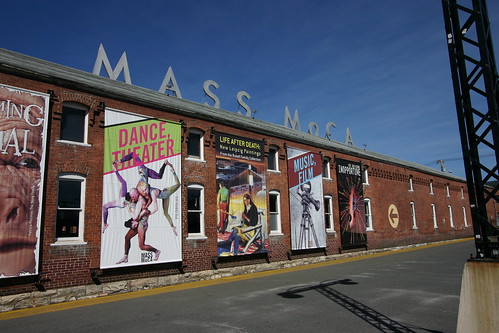Great article on the revival of Western Massachusetts towns via the arts
The reality is that arts-based revitalization doesn't replace mass manufacturing in terms of the number of people employed, and the ability to have relatively high paying jobs and low levels of educational attainment.
-- "When a Factory Town Becomes a Museum Town," Bloomberg Businessweek
But it's a lot better than doing nothing.
 Photo by Ben Kriete.
Photo by Ben Kriete. The story of Western Massachusetts, in particular North Adams and Pittsfield, is more interesting than I first realized because it was sparked by art museum director Thomas Krens, who went on to the Guggenheim Museum and used the same method--starting new arts institutions as a way to spark revitalization--but on an international scale, Bilbao being the most successful example ("Why can't the "Bilbao Effect" be reproduced? | Bilbao as an example of Transformational Projects Action Planning").
When I first got involved in commercial district revitalization c. 2002, I invested a bunch of time in nominating people from the neighborhood to attend the National Trust for Historic Preservation conference through "emerging leaders" scholarships (predominately for people of color, but not exclusively) and one of the people who attended the conference in 2003 mentioned to me an educational film she saw, "Downside Up: How the arts can change the spirit of a place," about arts-based revitalization in this area.
It was one of the first large scale arts-based revitalization programs I learned about and I tried to use it as a model for H Street NE area activities. In any case, it is one of the building blocks of my understanding, along with Paducah, Kentucky and their Artist Relocation Plan ("Lessons from Paducah, KY: Let Artists Revitalize Your Downtown," Cape Breton Spectator).
(Until they stopped sending them, I even subscribed to arts-related articles published by the Berkshire Eagle newspaper, to stay apprised of events and initiatives.)
I wrote about Pittsfield-North Adams more recently because of a follow on project involving Krens that I think is not likely to succeed ("Some museum matters") as well as a controversy involving the repositioning of the Berkshire Museum.
There are 2-3 important lessons from Pittsfield/Western Massachusetts that most people gloss over.
Be First. First, like with Bilbao ("THE BILBAO EFFECT’S SECRET INGREDIENTS: PLANNING, RELATIONSHIPS, FUNDING, IMPLEMENTATION," Europe in Baltimore; "The real Bilbao Effect is based on planning vision and complex relationships between levels of government + funding and implementation") and the Guggenheim Museum there, it's important to be a first mover.
And there were already arts-related assets in the region to build upon in Western Massachusetts.
Be Well Located/Accessible. Second, you need to be reasonably well-located.
Western Massachusetts is pretty easy to get to from the Boston area and from the New York City-Albany area. Paducah is accessible to most of the major cities in the Midwest via the Interstate Highway system.
There's a reason that building resorts or casinos in out of the way areas don't have a lot of revitalization success.
Arguably, Bilbao is hard to get to, but they have airport connections and with the large number of cheap airlines in Europe, it's not hard to get to by plane.
Have a great plan and be realistic rather than cheerlead. Third, you have to have a great plan, and not mess things up. This value is seen with the comparative failure of Valencia, Spain's creation of a number of seeming attractions designed by a high profile architect ("Valencia to sue Santiago Calatrava over at City of Arts and Sciences, Dezeen), but without the success of Bilbao. Although they weren't a first mover either.
Labels: arts-based revitalization, cultural planning, Transformational Projects Action Planning, urban design/placemaking



0 Comments:
Post a Comment
<< Home